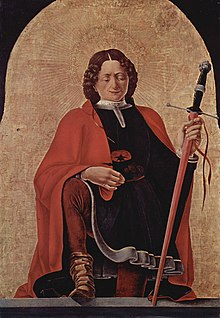Saint Florian
Saint Florian | |
|---|---|
 | |
| Soldier | |
| Born | AD 250 Aelium Cetium (present-daySankt Pölten,Austria),Roman Empire |
| Died | c.AD 304 Enns (river) |
| Venerated in | Catholic Church Eastern Orthodox Church[1] |
| Feast | 4 May |
| Attributes | depicted as a Roman officer or soldier; pitcher of water; pouring water over fire; invoked against fire, floods and drowning[2] |
| Patronage | Linz,Austria &Upper Austria;Kraków,Poland; chimneysweeps; firefighters; soap boilers |
Florian(Latin:Florianus;AD 250 –c.304) was aChristianholy man and thepatron saintofchimney sweeps;soapmakers, andfirefighters.Hisfeast dayis 4 May. Florian is also the patron saint ofPoland,the city ofLinz,Austria, andUpper Austria,jointly withLeopold III, Margrave of Austria.
Life
[edit]Florian was born around AD 250 in the ancient Roman city of Aelium Cetium, present-daySankt Pölten,Austria. He joined the Roman Army and advanced in the ranks,[3]rising to commander of the imperial army in the Roman province ofNoricum.In addition to his military duties, he was also responsible for organizing and leading firefighting brigades. Florian organized and trained an elite group of soldiers whose sole duty was to fight fires.[4]
During theDiocletianic Persecutionof Christians, reports reachedRomethat Florian was not enforcing the proscriptions against Christians in his territory. Aquilinus was sent to investigate these reports. When Aquilinus ordered Florian to offer sacrifice to theRoman godsin accordance withRoman religion,Florian refused. Florian was sentenced to be burned at the stake. Standing on the funeral pyre, Florian is reputed to have challenged the Roman soldiers to light the fire, saying "If you wish to know that I am not afraid of your torture, light the fire, and in the name of the Lord I will climb onto it."[5]Apprehensive of his words, the soldiers did not burn Florian, but executed him by drowning him in theEnns Riverwith amillstonetied around his neck instead.[3][4]
His body was later retrieved by Christians and buried at an Augustinian monastery nearLorch.Later a woman named Valeria had a vision in which she saw him; Florian, in this vision, declared his intent to be buried in a more appropriate location.[citation needed]
Veneration
[edit]Florian is very widely venerated inCentral Europe.[6]TheAustriantown ofSankt Florianis named after him. According to legend, his body was interred atSt. Florian Monastery,around which the town grew up.
Florian was adopted as patron saint of Poland in 1184, whenPope Lucius IIIconsented to the request of Prince Casimir II to send relics of Florian to that country.[3]Kraków thus claims some of his relics.[6]
A statue of Florian by Josef Josephu was unveiled in Vienna in 1935. It stood at the mainfirehouseof Vienna, in the city's main square, Am Hof. After the firehouse was bombed in 1945 duringWorld War IIthe statue was moved on to the Fire Brigade Museum (Wiener Feuerwehrmuseum).[2]
Seeking thesponsorship of a helpful saintwas and still is a part of the namegiving practice in Catholic areas. In the southern, Catholic, parts of theGerman Empire(mainly presentBavariaandAustria), peasants regularly have used the name, Florian, as one of the given names for at least one of their male children: to secure the saint's patronage against fire. Hence the given name is still widespread in these areas.[7]
St Florian was also celebrated in Hungary.
Two statues celebrating Saint Vendel and Saint Florian are in a small square in Zalavar village. They sit on separate similar plinths next to each other. (This arrangement and the style of the statues appears to be in the period 1900-1930.
The statues are not outside the village churches. (Many villages in west Hungary have two christian churches - catholic and protestant.)
Before 1920 german was the dominant language in hundreds of villages in Hungary, although Zalavar appears to be not in the main german speaking areas.
A Zalavar monument listing people who died in World Wars 1 & 2 has two or three names of german origin. Zalavar cemetery has very few graves displaying names of german origin. I
In oldest section of the cemetery furthest from the road most graves have no headstone.)
Patronage
[edit]Florian is a patron saint of Upper Austria and Poland; also firefighters, chimneysweeps, and brewers. Florian is associated with brewers because of a legendary incident in which he miraculously stopped a fire with a single pitcher of water. That is why he is often depicted holding a pitcher. Florian is also the patron of chimney sweeps, Austria, Poland and soap boilers.
Florian is invoked against fires, floods, lightning, and the pains ofPurgatory.[8]
A famousSt. Florian's Churchis located inKraków,Poland. Hisvenerationhas been particularly intense since 1528, when a fire burned the neighborhood without destroying the church.[9]
In contemporary culture
[edit]The "Florian Principle" (known in German language areas as "Sankt-Florians-Prinzip" ) is named after a somewhat ironic prayer to Saint Florian: "O heiliger Sankt Florian, verschon' mein Haus, zünd' and're an,"equivalent to" O Holy St. Florian, please spare my house, set fire to another one ". This saying is used in German much like the English"not in my back yard",when the speaker wants to point out that some person tries to get out of an unpleasant situation by an action that will put others in that very same situation.[10][11][12]
In Austria and Germany, "Florian" is the call sign for fire engines.[13][14]
The protagonist inFelix Salten'snovelFlorian: The Emperor’s Stallionwas named after Florian, as the animal was born on 4 May 1901 inLipizza,Austria.[15]
Alfred Schnittke's Symphony No. 2, is subtitled "St. Florian".[16]
In multiple cities across Slovakia, streets are named after Saint Florian, often in correlation with local fire departments. Florian Street (Floriánska ulica) occurs in historic boroughs of major cities: currently inKošice(Staré Mesto) and also formerly inBratislava(Staré Mesto).[17][18]
Gallery
[edit]-
St. Florian in St. Andrew's Church inAndraž nad Polzelo(Slovenia)
-
Statue of St. Florian at a crossroads nearKomarówka Podlaska(Poland)
-
Statue of Saint Florian, located above the altar at Saint Florian Catholic Church inIno, Wisconsin,United States
-
The Firefighter's Cross, sometimes mistakenly referred to as a St. Florian Cross[19]
-
Firefighter's Cross variant
See also
[edit]- St. Florian's Churchin Kraków, the resting place of St. Florian's relics
References
[edit]- ^(in Greek)Ὁ Ἅγιος Φλωριανὸς ὁ Μάρτυρας.4 Μαΐου. ΜΕΓΑΣ ΣΥΝΑΞΑΡΙΣΤΗΣ.
- ^abMendler, Mitch."Saint Florian – the patron saint of the fire service".Retrieved16 January2019.
- ^abc"St. Florian", Saint Florian Roman Catholic Church
- ^ab"St. Florian History", Brookline Firefighters Association, Brookline, Massachusetts.
- ^Turkalj, Nikola (2018).Rimski vojnik i vatrogasac.Split: Redak. p. 19.ISBN978-953-336-489-6.
- ^abSt Florian,Catholic.org. Accessed 27 September 2022
- ^For the frequency of this given name in Germany type "Florian"Archived25 September 2013 at theWayback Machine,gen-evolu.de. Accessed 27 September 2022.
- ^Lanzi, Fernando and Lanzi, Gioia:"Florian of Lorch, Martyr",Saints and Their Symbols: Recognizing Saints in Art and in Popular Images,pg. 86.Liturgical Press, 2004;ISBN0-8146-2970-9
- ^Internetowa Liturgia Godzin,brewiarz.pl; accessed 29 June 2020(in Polish).
- ^Ritter, Adolf Martin (2012).Studia Chrysostomica.Tübingen: Morh Siebeck. p. 2.
- ^Versnel, Henk (1981).Faith, Hope and Worship: Aspects of Religious Mentality in the Ancient World.Leiden: Brill. p. 19.
- ^Weszkalnys, Gisa (2010).Berlin, Alexanderplatz: Transforming Place in a Unified Germany.New York: Berghahn.
- ^Hegemann, Jan-Erik (4 May 2022)."St. Florian: Weit mehr als ein Heiliger".Feuerwehr-Magazin.Retrieved9 December2022.
- ^Funkrufnamenverzeichnis für den UKW-Sprechfunkdienst der nichtpolizeilichen Behörden und Organisationen mit Sicherheitsaufgaben (BOS)(PDF).Mainz: Ministerium des Innern und für Sport des Landes Rheinland-Pfalz. 2007. p. 12.Retrieved9 December2022.
- ^Salten, Felix (1934).Florian: The Emperor's Stallion.Translated by Erich Posselt and Michel Kraike. Indianapolis: The Bobbs-Merrill Company. p. 17.
- ^Ivashkin, Alexander:Alfred Schnittke,p. 141. London: Phaidon Press Limited, 1996.ISBN0-7148-3169-7
- ^"Katalóg ulíc:: Oficiálne stránky mesta Košice".www.kosice.sk(in Slovak).Retrieved29 March2022.
- ^"Stará mapa Floriánska - ulica (Staré Mesto) - mapa Bratislava rok 1960 - StareMapy.sk".www.staremapy.sk.Retrieved29 March2022.
- ^"The Myth of the" Maltese "Cross in the American Fire Service".9 August 2020.
External links
[edit]- Delehaye, Hippolyte(1911)..Encyclopædia Britannica.Vol. 10 (11th ed.). p. 539.
- Catholic Online article
- The Cult of St. Florian(with primary sources)
- St. Florian's Abbey in Austria
- Saint Florian the patron saint of the fire service
- Saints of Suds
- Firefighter's Cross symbols on historic firefighting objects,Staten Island Historical Society Online Collections Database
- Saint Florianat theChristian Iconographyweb site
- / "The Myth of the 'Maltese' Cross in the American Fire Service"







![The Firefighter's Cross, sometimes mistakenly referred to as a St. Florian Cross [19]](https://upload.wikimedia.org/wikipedia/commons/thumb/f/f9/FlorianCross_1.svg/120px-FlorianCross_1.svg.png)
